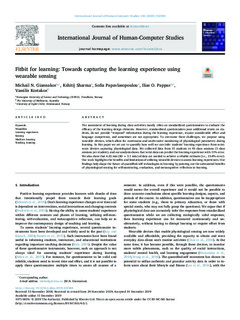| dc.contributor.author | Giannakos, Michail | |
| dc.contributor.author | Sharma, Kshitij | |
| dc.contributor.author | Papavlasopoulou, Sofia | |
| dc.contributor.author | Pappas, Ilias | |
| dc.contributor.author | Kostakos, Vassilis | |
| dc.date.accessioned | 2020-01-02T07:26:25Z | |
| dc.date.available | 2020-01-02T07:26:25Z | |
| dc.date.created | 2019-12-31T15:29:56Z | |
| dc.date.issued | 2020 | |
| dc.identifier.citation | International Journal of Human-Computer Studies. 2020, 136 | nb_NO |
| dc.identifier.issn | 1071-5819 | |
| dc.identifier.uri | http://hdl.handle.net/11250/2634533 | |
| dc.description.abstract | The assessment of learning during class activities mostly relies on standardized questionnaires to evaluate the efficacy of the learning design elements. However, standardized questionnaires pose additional strain on students, do not provide “temporal” information during the learning experience, require considerable effort and language competence, and sometimes are not appropriate. To overcome these challenges, we propose using wearable devices, which allow for continuous and unobtrusive monitoring of physiological parameters during learning. In this paper we set out to quantify how well we can infer students’ learning experience from wrist-worn devices capturing physiological data. We collected data from 31 students in 93 class sessions (3 class sessions per student), and our analysis shows that wrist data can predict the learning experience with 11% error. We also show that 6.25 min (SD = 3.1 min) of data are needed to achieve a reliable estimate (i.e., 13.8% error). Our work highlights the benefits and limitations of utilizing wearable devices to assess learning experiences. Our findings help shape the future of quantified-self technologies in learning by pointing out the substantial benefits of physiological sensing for self-monitoring, evaluation, and metacognitive reflection in learning. | nb_NO |
| dc.language.iso | eng | nb_NO |
| dc.publisher | Elsevier | nb_NO |
| dc.rights | Attribution-NonCommercial-NoDerivatives 4.0 Internasjonal | * |
| dc.rights.uri | http://creativecommons.org/licenses/by-nc-nd/4.0/deed.no | * |
| dc.title | Fitbit for learning: Towards capturing the learning experience using wearable sensing | nb_NO |
| dc.type | Journal article | nb_NO |
| dc.type | Peer reviewed | nb_NO |
| dc.description.version | publishedVersion | nb_NO |
| dc.source.volume | 136 | nb_NO |
| dc.source.journal | International Journal of Human-Computer Studies | nb_NO |
| dc.identifier.doi | 10.1016/j.ijhcs.2019.102384 | |
| dc.identifier.cristin | 1764569 | |
| dc.relation.project | Norges forskningsråd: 290994 | nb_NO |
| dc.relation.project | Norges forskningsråd: 255129 | nb_NO |
| dc.description.localcode | © 2019 The Author(s). Published by Elsevier Ltd. This article is available under the Creative Commons CC-BY-NC-ND license and permits non-commercial use of the work as published, without adaptation or alteration provided the work is fully attributed. | nb_NO |
| cristin.unitcode | 194,63,10,0 | |
| cristin.unitname | Institutt for datateknologi og informatikk | |
| cristin.ispublished | true | |
| cristin.fulltext | original | |
| cristin.qualitycode | 1 | |

